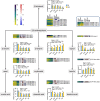Cuticular wax biosynthesis in blueberries (Vaccinium corymbosum L.): Transcript and metabolite changes during ripening and storage affect key fruit quality traits
- PMID: 38464479
- PMCID: PMC10923646
- DOI: 10.1093/hr/uhae004
Cuticular wax biosynthesis in blueberries (Vaccinium corymbosum L.): Transcript and metabolite changes during ripening and storage affect key fruit quality traits
Abstract
In fruits, cuticular waxes affect fruit quality traits such as surface color at harvest and water loss during postharvest storage. This study investigated the transcriptional regulation of cuticular wax deposition in northern highbush blueberries (Vaccinium corymbosum L.) in relation to fruit water loss and surface color during ripening and postharvest storage, as well as the effects of abscisic acid (ABA)-mediated changes in cuticular wax deposition on these fruit quality traits. Total cuticular wax content (μg∙cm-2) decreased during fruit ripening and increased during postharvest storage. Transcriptome analysis revealed a transcript network for cuticular wax deposition in blueberries. Particularly, five OSC-Likes were identified as putative genes for triterpene alcohol production, with OSC-Like1 and OSC-Like2 encoding mixed amyrin synthases, OSC-Like3 encoding a lupeol synthase, and OSC-Like4 and OSC-Like5 encoding cycloartenol synthases. The expression of three CYP716A-like genes correlated to the accumulation of two triterpene acids oleanolic acid and ursolic acid, the major wax compounds in blueberries. Exogenous ABA application induced the expression of triterpenoid biosynthetic genes and the accumulation of β-amyrin and oleanolic acid, as well as increased the ratio of oleanolic acid to ursolic acid. These changes were associated with reduced fruit water loss. The content of β-diketones was also increased by ABA application, and this increase was associated with increased fruit lightness (measured as L* using CIELAB Color Space by a colorimeter). This study provided key insights on the molecular basis of cuticular wax deposition and its implications on fruit quality traits in blueberries.
Keywords: Triterpenoids; abscisic acid; fruit color; fruit water loss; transcriptomics; β-diketones.
© The Author(s) 2024. Published by Oxford University Press on behalf of Nanjing Agricultural University.
Conflict of interest statement
No potential conflict of interest was reported by the authors.
Figures








References
-
- Fernández-Muñoz R, Heredia A, Domínguez E. The role of cuticle in fruit shelf-life. Curr Opin Biotechnol. 2022;78:102802 - PubMed
-
- Yan Y, Dossett M, Castellarin SD. Cuticular waxes affect fruit surface color in blueberries. Plants, People, Planet. 2023;5:736–51
-
- Yan Y, Castellarin SD. Blueberry water loss is related to both cuticular wax composition and stem scar size. Postharvest Biol Technol. 2022;188:111907
-
- Busta L, Jetter R. Moving beyond the ubiquitous: the diversity and biosynthesis of specialty compounds in plant cuticular waxes. Phytochem Rev. 2018;17:1275–304
LinkOut - more resources
Full Text Sources

